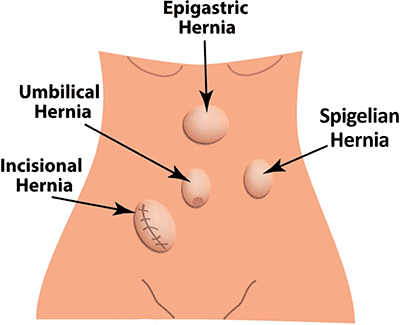
There are several different types of ventral hernias, also called abdominal wall hernias. At Hernia Clinic Hampshire, we have extensive experience with the types of hernias listed below. Our Consultant Surgeon is an expert in repairing ventral hernias in all manner of patients, young and old, male and female and with different health conditions and needs.
Here, we provide information on what the different types of ventral hernias are and our approach to repairing them. We aim to give you peace of mind about your hernia and your options.

Repairing hernias is a specialist task. Our team focuses on delivering the best personalised care and, therefore, only provides surgery for the following 4 types of ventral hernias.
We do not repair hiatus or parastomal hernias.
Paraumbilical hernias are also known as belly button hernias or umbilical hernias. These affect a weakness in your abdominal wall called the umbilicus, where the umbilical cord joins a growing foetus to the mum. While these hernias are common and can be present in anyone, obesity and pregnancy are common causes.
A true umbilical hernia is caused by an umbilical weakness that is present since birth, while a paraumbilical hernia is a new weakness located to the side of the umbilicus.
We recommend and offer paraumbilical hernia repairs under local anaesthetic and sedation . This innovative approach has been refined by our Consultant Surgeon over a number of years, and we are one of the only experts in Hampshire using this approach.
We chose this approach when possible because the recovery time is quicker, we can test your repair during your operation and patients are able to walk out of the hospital within hours after their hernia surgery.
Repair is straightforward but recurrence can be higher for this type of hernia than other types. Surgical repairs can only be attempted 2-3 times. To improve the chances of success, it is important to modify risks prior to the surgery, such as stopping smoking and achieving a BMI less than 33.
We have created an approach to repairing paraumbilical hernias that, in almost all cases, eliminates recurrence.
Under local anaesthetic and sedation: from £3,700
Epigastric hernias occur halfway between the bottom of the breastbone and the belly button. There is no natural weakness here, but damage to this site is a common cause. These hernias can push through one or both layers of connective tissue.
If they only come through one layer, some argue they are not technically a hernia, but they can still cause symptoms the same way a hernia can.
We recommend and repair epigastric hernias under local anaesthetic and sedation , in much the same way as a paraumbilical hernia (described above) with very similar results.
Under local anaesthetic and sedation: from £4,000
A spigelian hernia and a lateral hernia are the same thing. They are rare, and quite complex to explain.
Spigelian hernias come through muscle rather than connective tissue. They can be caused as our muscles weaken and are partially replaced by fatty tissue as we age. Spigelian hernias, or lateral hernias, also become more likely as abdominal pressure increases with activity or weight gain.
Increased pressure can cause the muscle fibres to part and a spigelian hernia to push through. While these hernias can push through 3 layers of muscles, they do not always push through all 3 layers which can make them symptomatic but hard to spot on clinical examination or imaging.
Spigelian hernias can be repaired under local anaesthetic and sedation, if it better suits the patient.
While these hernias are uncommon, at Hernia Clinic Hampshire we repair as many spigelian hernias in a year as most general surgeons will repair in their career. This experience has helped us gain expertise in the treatment and recovery from these hernias.
Under local anaesthetic and sedation: from £4,900
Under general anaesthetic: from £5,500*
(*prices can vary – talk to us for a price estimate)
Incisional hernias occur through an old surgical incision. The wound remodels and gains strength over the first year after surgery, but is never as strong as it was before the incision was made. The more times the same incision is opened, the weaker it becomes.
Additional risks include smoking, which prevents strong connective tissue, and a higher BMI, which puts more pressure on the abdominal wall, particularly where there is an old incision.
Repair of an incisional hernia is more complex and needs imaging as there are usually multiple defects that need repairs. When these additional defects are identified during surgery, they too can be repaired. This means incisional hernia repair surgery is performed under general anaesthetic .
It is particularly important to use a hernia support while recovering from this operation.
Prices can vary depending on your individual situation and the approach needed. Talk to us for a price estimate.
Large incisional hernias and other ventral hernias with multiple tissue defects are very difficult to repair and the surgery needs good planning. Component separation is a technique that is well practiced amongst hernia surgeons.
Over a wide area, the surgeon releases the fascia (connective tissue) from the muscle in order to reduce tension on the repair. This gives the surgeon more space to close the hernia defect.
This technique minimises tissue loss and reduces the risk of recurrence. It needs a general anaesthetic and an average stay of 2 nights after surgery.
Not looking for surgery to repair your ventral hernia? While surgery is the only way to fix it, we have developed a patient-tested and expert-recommended Hernia Recovery Programme to help you manage symptoms before hernia surgery, and improve results after surgery.
Depending on your hernia type, the surgery package price may vary, but they are all competitively priced and all-inclusive.
When you pay for a self-funded surgery package, it covers our expert Consultant Surgeon, Anaesthetist fees, Hospital fees, post-surgery follow up and access to our bespoke Hernia Rehabilitation Exercises.
By choosing to go private for your hernia surgery, you choose to reactivate your life through quick, high-quality hernia treatment. Financing can be arranged, and we also work with all medical insurance providers. We are able to provide the following price estimates:
(*prices can vary – talk to us for a price estimate)